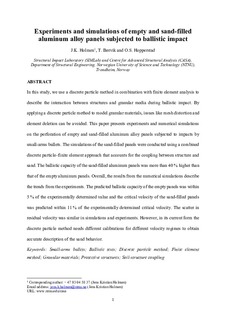| dc.contributor.author | Holmen, Jens Kristian | |
| dc.contributor.author | Børvik, Tore | |
| dc.contributor.author | Hopperstad, Odd Sture | |
| dc.date.accessioned | 2017-10-18T11:38:36Z | |
| dc.date.available | 2017-10-18T11:38:36Z | |
| dc.date.created | 2016-11-28T16:34:07Z | |
| dc.date.issued | 2017 | |
| dc.identifier.citation | Engineering structures. 2017, 130 216-228. | nb_NO |
| dc.identifier.issn | 0141-0296 | |
| dc.identifier.uri | http://hdl.handle.net/11250/2460806 | |
| dc.description.abstract | In this study, we use a discrete particle method in combination with finite element analysis to describe the interaction between structures and granular media during ballistic impact. By applying a discrete particle method to model granular materials, issues like mesh distortion and element deletion can be avoided. This paper presents experiments and numerical simulations on the perforation of empty and sand-filled aluminum alloy panels subjected to impacts by small-arms bullets. The simulations of the sand-filled panels were conducted using a combined discrete particle–finite element approach that accounts for the coupling between structure and sand. The ballistic capacity of the sand-filled aluminum panels was more than 40% higher than that of the empty aluminum panels. Overall, the results from the numerical simulations describe the trends from the experiments. The predicted ballistic capacity of the empty panels was within 5% of the experimentally determined value and the critical velocity of the sand-filled panels was predicted within 11% of the experimentally determined critical velocity. The scatter in residual velocity was similar in simulations and experiments. However, in its current form the discrete particle method needs different calibrations for different velocity regimes to obtain accurate description of the sand behavior. | nb_NO |
| dc.language.iso | eng | nb_NO |
| dc.publisher | Elsevier | nb_NO |
| dc.rights | Attribution-NonCommercial-NoDerivatives 4.0 Internasjonal | * |
| dc.rights.uri | http://creativecommons.org/licenses/by-nc-nd/4.0/deed.no | * |
| dc.title | Experiments and simulations of empty and sand-filled aluminum alloy panels subjected to ballistic impact | nb_NO |
| dc.type | Journal article | nb_NO |
| dc.type | Peer reviewed | nb_NO |
| dc.description.version | acceptedVersion | nb_NO |
| dc.source.pagenumber | 216-228 | nb_NO |
| dc.source.volume | 130 | nb_NO |
| dc.source.journal | Engineering structures | nb_NO |
| dc.identifier.doi | 10.1016/j.engstruct.2016.09.057 | |
| dc.identifier.cristin | 1405310 | |
| dc.relation.project | Norges forskningsråd: 237885 | nb_NO |
| dc.description.localcode | © 2016. This is the authors’ accepted and refereed manuscript to the article. LOCKED until 31.10.2018 due to copyright restrictions. This manuscript version is made available under the CC-BY-NC-ND 4.0 license http://creativecommons.org/licenses/by-nc-nd/4.0/ | nb_NO |
| cristin.unitcode | 194,64,45,0 | |
| cristin.unitname | Institutt for konstruksjonsteknikk | |
| cristin.ispublished | true | |
| cristin.fulltext | postprint | |
| cristin.fulltext | original | |
| cristin.qualitycode | 2 | |

